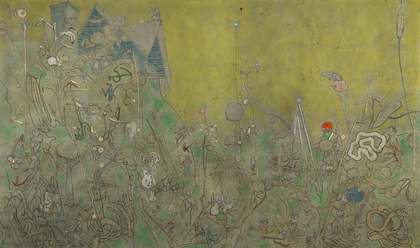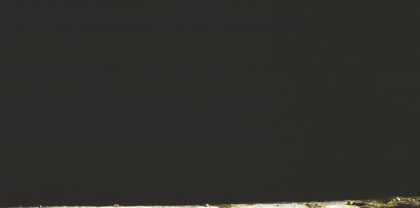This painting is called New Accursed Art Club, and I painted it in 2007 and it was purchased by the Tate in 2008. I was trying to suggest a reactionary kind of conservative group of makers who are involved in mutual appreciation and supporting each other against the wider world, which is kind of how art often seems to work, as people kind of flock together in little teams and little groups to affirm their position, because it’s a vulnerable place to be. The reason why I’m really happy that this ended up here at the Tate, is that it kind of has everything. It’s one of the… you know, when I make a body of work, there’s always one painting that spawns the others, that the others are kind of satellites off, that it opens up a new place, and then you sort of feed on it for like a couple of years; and this was one of those paintings; it was one of the kind of… it was a groundbreaking painting for me, and I’m very sentimental and fond of it for that reason, because I realize I know what went into it, but I also know what it achieved for me in my work. It has all of the things that I enjoy making, and to be blunt, it has all of the things that I like about my work. I’ve started making these archives of paintings, the life of the painting as it’s progressing through time. The painting began in September 2007. This is really the early days of that. They are starting to be sort of fleshed out and pushed around a little bit. The technical process in the early days is very linear, with a kind of filling in that takes place. So I try a few things out. Early on this kind of forest scene is thrown in, which is quite detailed. Painting over the thing completely in white, and then finding the image again, it throws up new shapes and new sort of images. But again, I’m still sort of painting things in and out again, painting over them and then pulling them back through the white. It really does remind me of archaeologists with dinosaur bones, you know, sort of dusting off the soil and things around and just trying to raise this thing out of the earth. It’s very much how I feel when I’m making the work. And originally there was this kind of sun motif which I dragged from an earlier painting of mine, called Morning is Broken. But often with me, once… I know when I do that, that there’s something wrong, as soon as I start using something from another painting, it’s kind of dying, something isn’t working. But it’s actually helping with these two – it’s informing their relationships and how they’re lit, and everything. And often what I like about the paintings is the kind of mystery of the making, so you can put a big sun in like that and group everyone around the sun, and then just take the sun out, and then you’ve got this kind of sudden vacuum, and it creates a real tension in the painting. You can’t see that it was there, but because it was, there’s a sort of memory of it in the paint. So that created a nice kind of area there that immediately suggested a building as a way of compressing the thing; a kind of fictional architectural conglomerate, like a weird block that isn’t really anything. That’s to me the magic of painting; you can actually author the universe of the work in some sort of way. And what people do, and the actions that take place, are all part of painting, adding words that aren’t spelt properly. You think, well, it’s them thinking it – it’s the figures dreaming it – but it’s also me doing it. So you get to double up on your own sort of personality in some way. I kind of like the fact that the painting has its own logic, and you just have to let it be what it is.



